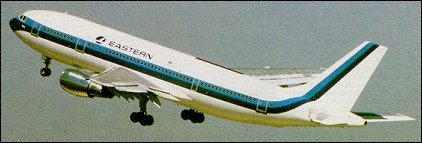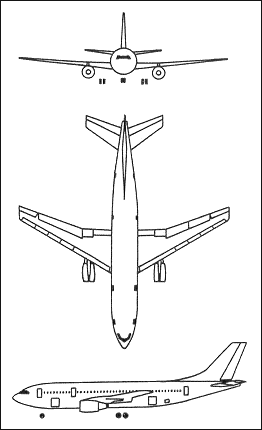|
| At a similar time as Boeing in the USA was finalising the design of the world's first wide-body, the Model 747, discussions were starting in Europe to consider the production of a large capacity short-range European transport aircraft. During 1965-66, various alignments of European manufacturers studied different designs, the most promising being the HBN-100 developed by Hawker Siddeley, Breguet and Nord.
On 28 May 1969, France and West Germany decided to go ahead with the development of the European Airbus, as it had become, with Hawker Siddeley keeping alive the British interest despite the lack of government support. Construction of the A300 began in September 1969, and in December 1970 Airbus Industrie was established to oversee the project. The General Electric CF6 turbo-fan was chosen as the main powerplant, but any engine in the same class could be substituted on production models according to customer wishes. The cylindrical fuselage could accommodate seating layouts from 220 to a maximum of 336 passengers, although most users would choose a multi-class layout to reflect the business nature of European operations. The advanced wing was a Hawker Siddeley design, with a full suite of high-lift devices.
The first two aircraft were designated A300B1 and the first (F-WUAB) made its inaugural flight on 28 October 1972, the second following on 5 February 1973. These were followed by the first pair of A300B2s, this considered the production model. The first four completed a lengthy flight test programme to allow European certification to be granted on 15 March 1974, US certification following on 30 May. This date also saw the first airline service, by Air France between Paris and London. At once the A300 impressed passengers with its comfort and quietness, the latter a factor appreciated by those living near the airports it visited.
Initial sales were slow, and there seemed little chance of breaking the US market until 6 April 1978, when Eastern Air Lines ordered the first of 38 A300s. These were the A300B4 variant, with increased fuel capacity, Kruger leading edge flaps and increased gross weight for longer range. The British government also finally joined the consortium in 1978, taking a 20 per cent stake in the project. Aerospatiale and Deutsche Airbus remained the principal partners (37.9%) with Spain's CASA having a 4.2% stake. Two other companies became associates of the programme, the Dutch Fokker concern and the Belgian organisation Belairbus.
Since 1978 the A300 story has been one of gradual development. The A300C4 was introduced as a convertible freighter version with a large cargo door in the port side. This and the passenger-only model have been superseded by a new series incorporating an
extra row of seats, a new two-man forward-facing cockpit and a comprehensive list of small drag-reducing and weight-reducing items. The resultant A300-600 first flew on 8 July 1983, and has been the major production version since, the last A300B4 leaving the line in late 1984. Versions include the A300-600R with increased take-off weight and tailplane trim tank for long-range operations, and the A300-600 Convertible passenger/cargo version.
| MODEL | Airbus A300-600 |
| PASSENGERS | 220-336 |
| ENGINE | 2 x Pratt & Whitney PW4156 turbofans, 250kN |
| WEIGHTS |
| Take-off weight | 165000 kg | 363765 lb |
| Empty weight | 78200 kg | 172402 lb |
| DIMENSIONS |
| Wingspan | 44.84 m | 147 ft 1 in |
| Length | 54.08 m | 177 ft 5 in |
| Height | 16.62 m | 55 ft 6 in |
| Wing area | 260 m2 | 2798.61 sq ft |
| PERFORMANCE |
| Cruise speed | 890 km/h | 553 mph |
| Range | 7000 km | 4350 miles |
| lxbfYeaa, e-mail, 15.11.2025 11:49 20 reply | | lxbfYeaa, e-mail, 07.11.2025 04:00 20 reply | | ubaTaeCJ, e-mail, 21.02.2025 21:02 20 reply |
| ubaTaeCJ, e-mail, 21.02.2025 11:49 20 reply |
|
| | ubaTaeCJ, e-mail, 21.02.2025 11:49 20 reply |
| lxbfYeaa, e-mail, 17.11.2024 01:03 208mEtLcII reply |
| lxbfYeaa, e-mail, 17.11.2024 01:02 20 reply |
| lxbfYeaa, e-mail, 17.11.2024 01:01 20 reply |
| lxbfYeaa, e-mail, 17.11.2024 01:00 20 reply | | lxbfYeaa, e-mail, 17.11.2024 00:57 20 reply | | lxbfYeaa, e-mail, 17.11.2024 00:50 20 reply | | lxbfYeaa, e-mail, 17.11.2024 00:25 20 reply | | lxbfYeaa, e-mail, 17.11.2024 00:22 20 reply | | lxbfYeaa, e-mail, 17.11.2024 00:21 20 reply |
|
| | lxbfYeaa, e-mail, 17.11.2024 00:20 20 reply | | lxbfYeaa, e-mail, 17.11.2024 00:18 20 reply | | lxbfYeaa, e-mail, 17.11.2024 00:16 20 reply |
| lxbfYeaa, e-mail, 17.11.2024 00:11 20 reply | | lxbfYeaa, e-mail, 17.11.2024 00:11 20 reply | | lxbfYeaa, e-mail, 17.11.2024 00:02 20 reply |
|
Do you have any comments?
|
| 
COMPANY
PROFILE
All the World's Rotorcraft
|








 ubaTaeCJ
ubaTaeCJ
20
reply